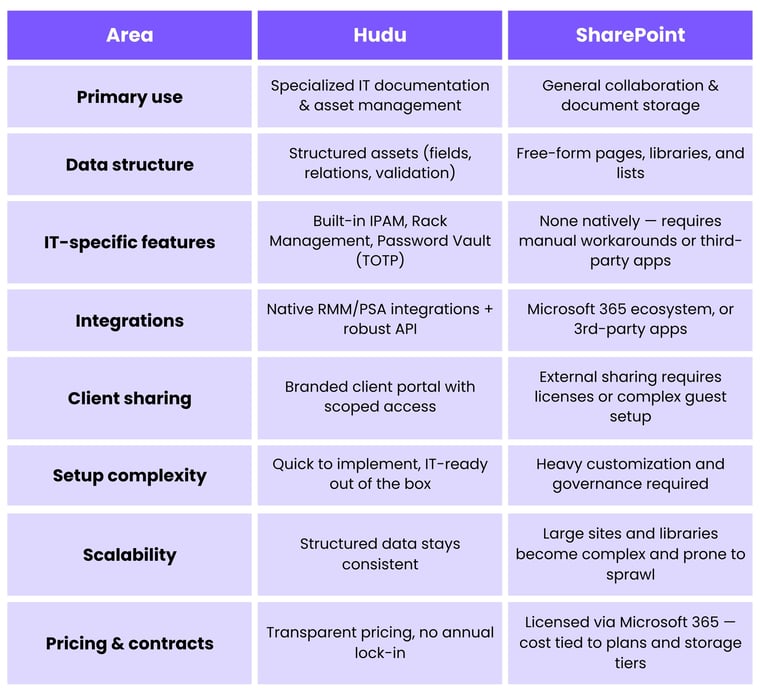
Built for IT, not just file storage
Microsoft SharePoint is a powerful platform for file storage, collaboration, and intranet sites. But while it works well as a general-purpose knowledge repository, it isn’t designed for structured IT documentation.
Hudu is purpose-built for IT teams and MSPs. With asset templates, IP Address Management, Rack Management, an integrated password vault, and native PSA/RMM integrations, Hudu delivers everything IT teams need — without the sprawl, customization overhead, or patchwork of add-ons.The challenges IT teams face with SharePoint
- Not IT-specific: No built-in IPAM, rack layouts, or password vault.
- DIY customization: Requires heavy manual setup for fields, tables, and processes.
- Client access limitations: External sharing is complex and difficult to scope securely per client.
- Content sprawl: Without strict governance, sites quickly become disorganized.
- Performance issues: Large libraries or workflows can slow down and break.
- Integration reliance: Advanced workflows often require third-party tools.
- Admin overhead: Managing permissions, versions, and access requires constant upkeep.
How Hudu solves IT documentation
Purpose-built for IT teams and MSPs.
- Structured IT assets: Drag and drop form builder for structured documentation, relationships, validation, plus Rack Management and IPAM.
- Secure passwords & TOTP: Built-in, linked to assets and clients.
- Client-ready portals: Branded, secure sharing without guest hacks.
- Screen Capture to SOPs: Instantly turn clicks into knowledge base articles and processes.
- RMM/PSA integrations: Auto-import devices, sync companies, and surface live context next to documentation.
- Robust API: Extend Hudu or connect any tool if you need a custom workflow.
- Predictable cost: Transparent pricing, no lock-in contracts.
- In-house support: Real IT experts, not ticket queues. Over 95%+ customer satisfaction.
Feature Comparison: Hudu vs SharePoint
Primary use case:
- Hudu: Specialized IT documentation & asset management
- SharePoint: General collaboration & document storage
Data structure:
- Hudu: Structured assets (fields, relations, validation)
- SharePoint: Free-form pages, libraries, and lists
IT-specific features:
- Hudu: Built-in IPAM, Rack Management, Password Vault (TOTP)
- SharePoint: None natively — requires manual workarounds or third-party apps
Integrations:
- Hudu: Native RMM/PSA integrations + robust API
- SharePoint: Microsoft 365 ecosystem or 3rd-party apps
Client sharing:
- Hudu: Branded client portal with scoped access
- SharePoint: External sharing requires licenses or complex guest setup
Setup complexity:
- Hudu: Quick to implement, IT-ready out of the box
- SharePoint: Heavy customization and governance required
Scalability:
- Hudu: Structured data stays consistent
- SharePoint: Large sites and libraries become complex and prone to sprawl
Pricing & contracts:
- Hudu: Transparent pricing, no annual lock-in
- SharePoint: Licensed via Microsoft 365 — cost tied to plans and storage tiers

Why structured data matters
For IT documentation, structure beats scattered pages. Hudu ensures IT documentation is organized, reportable, and a single source of truth:
- Assets, networks, and credentials are linked together.
- Predefined fields and validation keep data consistent.
- Expirations, passwords, and client views stay accurate.
SharePoint excels at team collaboration and file storage, but it wasn’t built to manage IT assets, networks, or credentials in a structured way.

Integrations: Automate documentation
- Native integrations: Connect directly with leading RMM, PSA, and network tools for automatic device and client imports.
- Robust API: If we don't have it yet, you can build it. Automate workflows, connect tools, and customize your stack without waiting.
 SharePoint, by contrast, relies on Microsoft 365 ecosystem apps or third-party connectors — often requiring manual configuration and extra licensing.
SharePoint, by contrast, relies on Microsoft 365 ecosystem apps or third-party connectors — often requiring manual configuration and extra licensing.

When Hudu makes sense
Hudu is the right choice if your team needs:
- Structured IT documentation (assets, racks, IPs, passwords).
- Client-ready knowledge sharing with branded portals.
- Efficient workflows that save time with built-in tools.
- Secure password management baked into your documentation.
- On-demand support with no long-term contracts.
- Rapid release cycle driving an innovative, adaptive documentation system.
FAQs
Is SharePoint good for IT documentation?
It can be adapted, but requires constant customization and governance. Hudu is IT-ready out of the box.
Can SharePoint replace a password manager?
No. Hudu includes a secure password vault with TOTP built in.
Does Hudu integrate outside of Microsoft 365?
Yes. Hudu is vendor-agnostic with native integrations across PSAs, RMMs, and IT tools.
Will Hudu scale with my team?
Yes. Structured data and asset-level permissions make Hudu scalable for growing MSPs without slowing performance.
Summary
SharePoint is a powerful collaboration tool. Hudu is a complete IT documentation platform.
Hudu gives you structured data, IT-ready features, client portals, and best-of-breed integrations — without the complexity of bending a collaboration platform into an IT tool.
More from Hudu...
View All PostsSubscribe to Our Blog
Stay up-to-date on all Hudu happenings including releases and articles.



